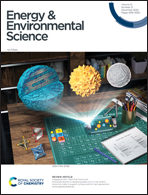A phytophotonic approach to enhanced photosynthesis†
Abstract
Photosynthesis is the dominant biotic carbon sink on earth and hence presents an opportunity for enhanced sequestration of CO2. If the average net carbon fixation efficiency of terrestrial plants could be increased by 3.3%, all anthropogenic CO2 accumulating in the atmosphere could instead be reduced and incorporated into terrestrial biomass. Plants make inefficient use of the overly abundant sunlight available to them, a result of having evolved to be competitive and survive highly dynamic environmental conditions rather than maximize photosynthetic productivity. We explore herein a phytophotonic approach to enhanced photosynthesis, whereby sunlight is redistributed by means of luminescent or persistent luminescent (PersL) materials. Phytophotonics has potential at varied scales, ranging from photobioreactors to greenhouses all the way to crops in the field, the latter having the potential to impact planetary CO2 levels. The approach is three-fold: a spectral redistribution to relieve high-light-stress at the top surface of leaves and increasingly drive photosynthesis deeper in leaves and canopies; a minute-scale temporal redistribution to bridge periods of intermittent shade and reduce shock associated with variable light conditions; and a multiple-hour temporal redistribution to shift a fraction of high-intensity midday lighting to evening hours. Based on simulations of photoluminescent materials and light quality experiments with a model algal system, it is shown that while lengthening daylight hours will require significant improvements in PersL materials, the other two approaches show more immediate promise. We demonstrate a means of concentrating PersL light from SrAl2O4:Eu,Dy, approaching levels needed to effectively bridge periods of natural shade, and outline the scientific questions and technical hurdles remaining to realize the benefits of the proposed spectral shift.



 Please wait while we load your content...
Please wait while we load your content...
